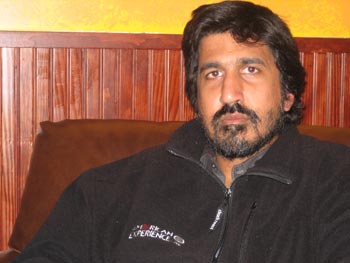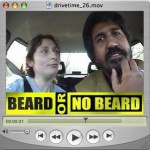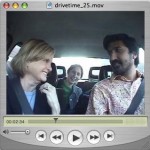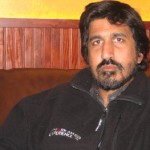Lounging in the cozy chairs of Emack & Bolio’s, Ravi Jain and I recently took time out to sip tea and discuss his life online. The 35-year-old MassArt grad has been making a lot of friends with his vlog “DriveTime”, which he produces with his wife Sonia, and we talked at length about the immediacy of the web, traditional versus new media, robots, Sweden, and how to turn one’s life into a sitcom.
Ravi’s first show, “Three Abreast”, went online in 2002. Produced while he was at MassArt, this 7-episode series stuck to the format of the traditional sit-com, following the hijinks of three wacky roommates. “I had lived in Stockholm, Sweden for a number of years before I came back to go to MassArt for my MFA. In Stockholm it is impossible to find an apartment,” he says of the inspiration for his show. “I moved back to Boston, into this house with roommates. It was in Jamaica Plain, and we were all right around turning thirty, and we were all kind of losers so we were all single. We were always hanging out together and these wacky adventures would proceed to happen.”
The original idea, he says, was quite fluid. “I came up with the idea of doing a web-based sitcom about the house. I thought that since it was on the web it needed to be short form, and it had to have some interactive content to it. When I wrote the batch of scripts, it really was about that first year and this glowing appreciation and love for having that situation.”
The premise of the show, following three roommates, echoes classic sitcoms like “Three’s Company” and “The Young Ones”, and Ravi acknowledges that having his roommates support was vital to the success of the show. “They were on board, but definitely toward the end I was pushing my luck. There was one shoot, it was in July and it was like 99 degrees, and it was period episode, the Victorian flashback. Everyone had these heavy costumes on.”
He pauses to laugh at the memory.
“I don’t think anyone knew how elaborate it would get, doing what I think was a semi-professional shoot, meaning setting up lighting and doing multiple takes and that sort of stuff. We got better at it, also. It got quicker and if they didn’t have their enthusiasm then we couldn’t have done it.”
“Three Abreast” is now over and gone, fondly remembered by many and yet, despite renewed interest, only one episode is currently online, and can be found here. But Ravi hasn’t been sitting still, and has turned his attention to the burgeoning ‘vlog’ culture.
For the uninitiated, a vlog (video blog) is an evolution of the ubiquitous blog, presenting content with video rather than text. His show, “DriveTime” is a rising star of the vlogosphere, consistently original and engaging, and you can sense Ravi’s excitement as he describes the origin and the concept.
“I always thought that I didn’t just want to turn on the camera and say ‘Hey, this is my video blog.’ It’s not that I don’t think that’s legitimate, because a lot of people do that and it’s interesting, I just don’t think I’d be one of those people. I work much better if there is some tight concept. So I was thinking about what I could do that is a tight concept, and more importantly what I could do that I could do consistently. What I learned from looking at video blogs and blogging in general is that you have to be able to make some commitment to regularly updating the content. When am I going to be able to do that?”
“So, I was thinking about this as I was driving to work, and I was sitting at a red light. I realized ‘Wait, what if I could do something while I drive to work?’”
”I’ve got about a half-hour commute each day, which is like an hour a day in the car. So I thought if I could actually make the car my studio, that’s five hours of studio time a week. That’s more time than I would ever dedicate to work, if I ever set aside a night to do my art, I’d be lucky to set aside three hours, and this is five hours.”
“So I asked myself what I could do in the car, maybe shoot in the car, and I started working that concept around. I thought if it was just me yammering on, after a couple of episodes that would get boring. But what if it was like a talk show?”
“I really thought about why people watch talk shows, and some of it is the familiarity with the schticks and all that, but it really is about the guests. ‘Who’s on? Oh so-and-so is on Carson.’ That shows how dated I am, I’m talking about Carson. I should just say ‘The Parr Show’.”
“So I thought about guests, and it became this puzzle. How could I get guests while I’m going to work and that had to be the backbone, not just the gimmick. It really had to be while I’m going to and from work.”
“DriveTime” is now, as of this writing, at it’s twenty-sixth episode. They are fun to watch, and the overall effect is somewhere between a talk show and a peek into the personal life of Ravi and Sonia. Their car, an Audi they call ‘Studio A’, is the site in which viewers become a part of their life, if only for a short time each day, and is often a character unto itself. Ultimately, though, it’s the guests that make “DriveTime” a success.
“We’ve had different artists from the Boston community. We’ve had musicians on. James Hull was an early guest, talking about Green Street Gallery. Gaelin Palmer was actually our first guest, she is a photographer and she was on to talk about some of her work. Tony Kahn, who is a big podcaster guy. We’ve had a lot of people in the arts because that’s our circle, but then also a lot of people from the technology circle.”
“The great thing about living in this blog environment is that I get this feedback instantaneously, and I utilize it. The first time I had a guest, people left comments saying that I was talking over the guest, and that I needed to let my guest answer. So I made up a sticky, with my high budget, I made a post-it note that said ‘Shut up, Ravi’ and I put it on my shifter. Then the next guest was James Hull, and I was all afraid to say anything.”
“There was a guy who was the chair of this FIRST Robotics Competition up in Stoughton. It was started by Dean Kamen, the Segway guy, and they have all these high school kids that build robots and they have to compete. Each year it is a different competition, but this year it involved shooting balls through these circles of big plexi-glass. They have to work together as teams with other schools.”
“So, this guy came on and talked about it, and it was really great, really crazy stuff. When that episode got posted, that night someone from West Roxbury wrote and said ‘I’m a teacher, we’ve got a team competing tomorrow. You’re welcome to come down onto the pit floor.’ So we went down there and were his guest.”
“DriveTime” is always evolving, and Ravi has big plans for the future. For fans of the show, whose comments can be read on his website, these changes have evolved from the internal logic of the show and the suggestions of the audience. Recently Ravi had grown a beard for the winter, and left it to his audience to decide “Beard Or No Beard?” by leaving responses on his site. When asked about his plans for the future, Ravi is open to suggestions, but is careful to keep “DriveTime” true to it’s original idea.
“We introduced a new running character a few weeks ago, Anna The Coffee Gal, and all you see is her arm. She gives us coffee. I like this character because she gives us free coffee. I think slowly we’ll develop her. What’s her motivation? What’s driving this arm to deliver us coffee?”
Links:
Drivetime
Three Abreast pilot episode: "Bigger Night"
Ravi Jain
All images are courtesy of Ravi Jain.






